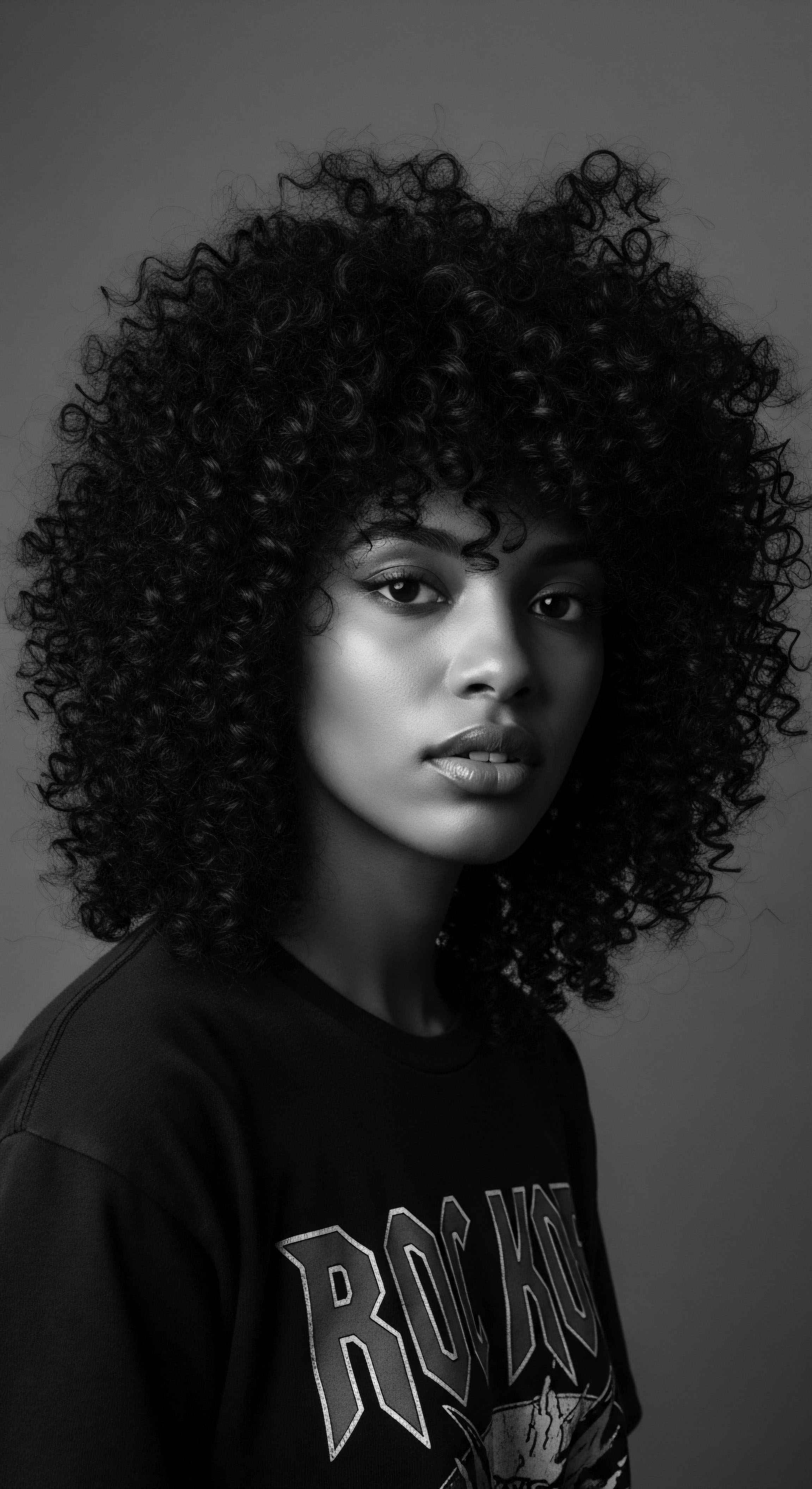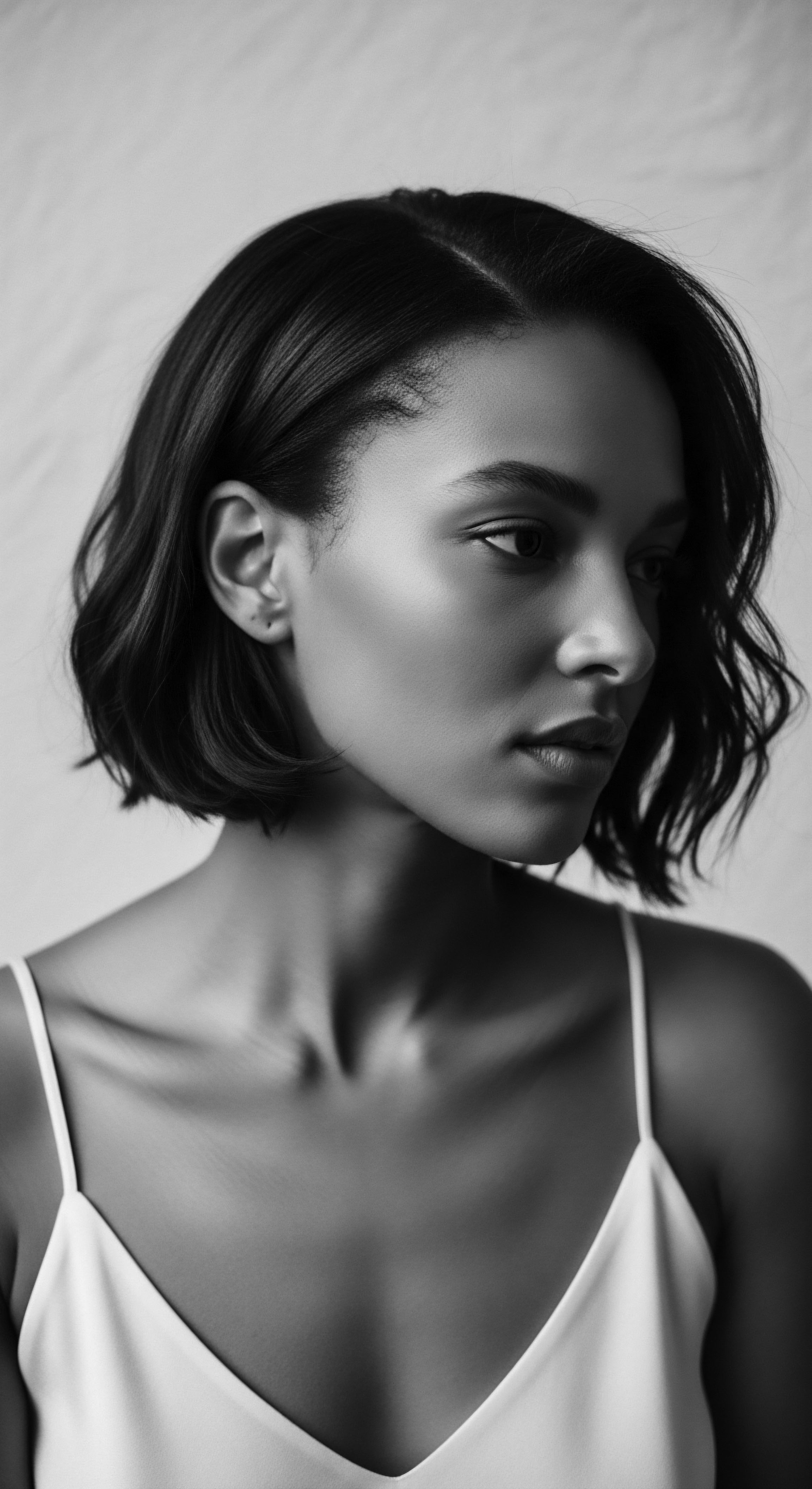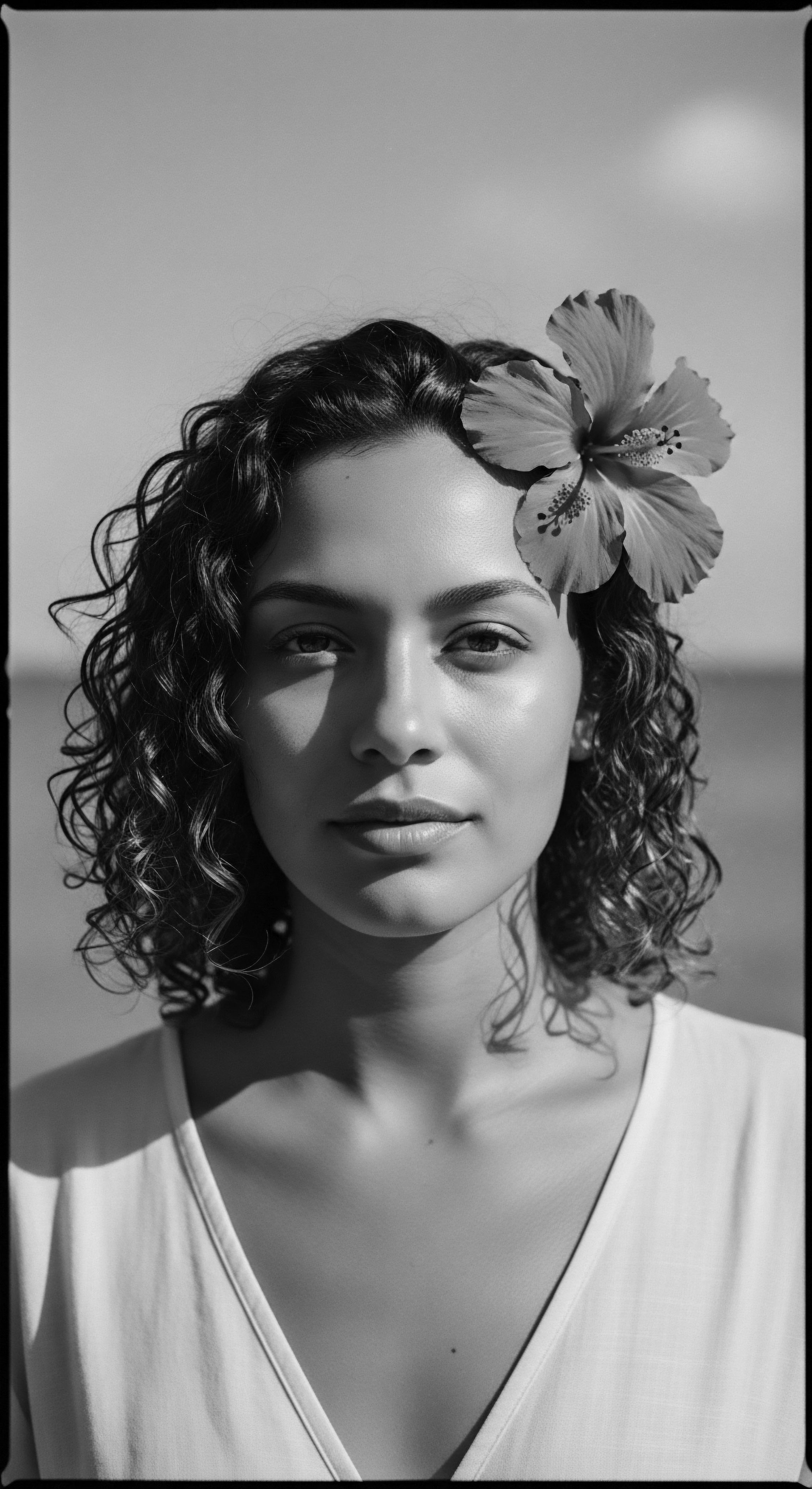
Roots
When we speak of hair, particularly the tightly coiled, wavy, or spiraled strands that mark a heritage of resilience and beauty, we speak of more than mere aesthetics. We delve into a profound lineage, a story etched in every bend and loop of the fiber. How hair’s curl pattern relates to moisture is not merely a biological curiosity; it forms a cornerstone of ancestral wisdom, shaping care rituals passed down through generations.
Consider the touch of a grandmother’s hands as she oils a child’s scalp, the rhythmic braiding circle under the African sun, or the whispers of secrets shared as coils are tended – these are not random acts. They are responses, deep and knowing, to the very nature of textured hair and its elemental need for hydration.
The very structure of a strand, viewed through the lens of history and biology, offers clues. Hair, at its fundamental core, consists of a protein called keratin. This keratin forms three layers ❉ the inner medulla, the middle cortex, and the outer cuticle. The cuticle, a layer of overlapping scale-like cells, acts as a protective shield.
In hair with a tighter curl, these cuticle scales naturally sit more lifted or raised than in straight hair. This anatomical characteristic, determined by the elliptical or flattened shape of the hair follicle from which the hair grows, creates a paradox ❉ textured hair readily welcomes moisture, yet it can also release it with equal ease. This inherent openness, while permitting products to enter the hair shaft, also makes it prone to rapid moisture loss, leading to dryness and frizz. Understanding this fundamental interplay between geometry and hydration is key to appreciating the traditional care practices that blossomed across diasporic communities.
The intrinsic geometry of textured hair, stemming from its curved follicle, shapes its relationship with moisture, requiring intentional and consistent hydration.

Understanding the Curl’s Hydration Demands
The journey of natural oils, known as sebum, from the scalp along the hair shaft also varies significantly with curl patterns. In straight hair, sebum can glide unimpeded from root to tip, coating the strand evenly. For textured hair, the turns and spirals act as natural barriers, impeding the even distribution of these protective oils.
This leaves the ends, especially, prone to dryness, requiring external intervention to supplement the scalp’s natural offerings. This biological reality, a silent language spoken by each strand, necessitated the development of sophisticated moisturizing practices within ancestral communities, traditions that often centered on the power of plant-derived emollients and humectants.

Ancient Knowledge of Hair Porosity
The concept of hair Porosity, which describes hair’s capacity to absorb and hold water, while a modern scientific term, was understood intuitively by ancestral caregivers. They observed how different hair types responded to rain, humidity, or applied oils. This observation informed their selection of natural ingredients and techniques. For instance, highly porous hair, with its more open cuticles, would readily absorb water but also lose it quickly.
Low porosity hair, with its tightly sealed cuticles, resists water initially but, once hydrated, holds moisture for longer periods. The deep respect for diverse hair characteristics, long before microscopes revealed cellular structures, guided a tailored approach to hair wellness rooted in observable phenomena.
| Aspect of Hydration Moisture Loss |
| Ancestral Observation "Hair feels dry quickly after wetting or in dry air." |
| Modern Scientific Explanation Lifted cuticles allow water molecules to escape rapidly from the hair shaft. |
| Aspect of Hydration Oil Distribution |
| Ancestral Observation "Ends often feel drier than roots." |
| Modern Scientific Explanation The coiled structure hinders sebum from traveling uniformly down the strand. |
| Aspect of Hydration Product Absorption |
| Ancestral Observation "Some hair drinks up oils, others resist." |
| Modern Scientific Explanation Porosity, determined by cuticle integrity, dictates how easily substances penetrate the hair. |
| Aspect of Hydration The ancient wisdom of hair care, born from observation, finds validation in contemporary scientific understanding. |

Ritual
The relationship between hair’s curl pattern and its moisture needs found its most tangible expression in the ceremonial and practical rituals that define textured hair heritage. These practices, far from being simplistic, were sophisticated responses to the hair’s inherent biology, evolving over centuries within diverse Black and mixed-race communities. They were often communal events, a sharing of wisdom and connection, where care was woven into the fabric of identity.
Consider the deep history of Oiling and Buttering, especially prevalent across African traditions. The very nature of coiled hair, with its propensity for dryness, demanded rich, emollient substances to seal in hydration and protect the strand. For millennia, African communities turned to the gifts of their land. Shea butter, sourced from the karité tree ( Vitellaria paradoxa ) in West Africa, serves as a powerful historical example.
Used for thousands of years, with archaeological evidence suggesting its presence on ancient Egyptian mummies, shea butter acted as a multi-purpose balm, offering protection from harsh climates and moisturizing both skin and hair (Diop; Gallagher et al. 2023). Its ability to form a protective film around the hair cuticle helps to trap much-needed moisture, a technique understood through generations of observation. This ancestral practice of deep oiling, often coupled with infrequent washing, directly countered the hair’s tendency to lose hydration quickly.
Traditional hair rituals, born from the innate characteristics of textured hair, provided both physical care and a profound connection to collective heritage.

How Does Ancestral Styling Protect Against Moisture Loss?
Protective styles, a cornerstone of textured hair heritage, offer another layer of insight into managing moisture. Braids, twists, and cornrows, with origins stretching back to 3500 BCE, served not only as markers of status, tribal affiliation, or marital standing, but also as ingenious methods of safeguarding the hair. By keeping the hair bundled and contained, these styles minimize exposure to environmental elements that draw out moisture, such as dry air or wind.
They also reduce the need for daily manipulation, which can lead to breakage and further compromise the cuticle’s integrity, impacting moisture retention. The intricate artistry of these styles, therefore, carried a profound functional purpose, allowing natural oils to accumulate and providing a stable environment for hydration.
The choice of implements also speaks to this intuitive understanding. Wide-toothed combs, crafted from natural materials, were employed to detangle damp hair gently, minimizing breakage—a crucial step for curls already susceptible to fragility due to their structure. The tools were extensions of care, their design reflecting a deep awareness of the hair’s needs.
- Shea Butter ❉ A rich emollient, traditionally extracted and used across West Africa for its moisturizing and protective properties on both skin and hair.
- Coconut Oil ❉ Found in many African hair care routines, praised for its ability to moisturize deeply and protect against protein loss.
- Chebe Powder ❉ Used by the Basara women of Chad, this powder blend aids in retaining moisture and increasing hair thickness, thereby promoting length retention.
- Marula Oil ❉ From southern Africa, this oil is prized for its light texture and rich moisture content, effectively hydrating hair.

The Evolution of Care ❉ Connecting Past and Present
The legacy of these rituals resonates today. Modern hair science validates the wisdom of these ancestral practices, providing a molecular explanation for the centuries-old observations. Humectants, substances that attract water from the environment, and emollients, which create a barrier to seal in moisture, are now staples in contemporary textured hair products.
The scientific understanding of how these compounds interact with the hair’s protein structure and cuticle layer simply adds a deeper layer of comprehension to what tradition already knew. The continuity of care, from the ancient use of plant butters to the sophisticated formulations of today, highlights an unbroken chain of knowledge and adaptation.
The communal act of hair care, particularly braiding, often became a quiet form of resistance during times of oppression, such as the period of enslavement in the Americas. Stripped of traditional tools and practices, individuals used braiding as a means of identity preservation and even communication, coding escape routes within intricate patterns. This historical context lends a poignant weight to the rituals of hair care, transforming them from mere beauty routines into powerful acts of cultural survival and self-expression.

Relay
The intricate dance between hair’s curl pattern and its moisture requirements reaches its most sophisticated understanding when we consider it not just as biology or historical practice, but as a living, evolving system of care, a continuous relay of knowledge across generations and contexts. This deeper understanding moves beyond surface-level solutions, embracing a holistic perspective that integrates scientific inquiry with the profound wisdom of textured hair heritage.

How Do Environmental Factors Impact Moisture for Coiled Hair Across Regions?
The environments where ancestral care practices developed were often challenging. Hot, dry climates in many parts of Africa necessitated intense moisturizing and protective methods to guard against dehydration. Conversely, communities in more humid environments still needed to manage moisture balance, perhaps focusing on techniques to prevent frizz caused by excessive absorption of atmospheric water. This adaptability to diverse climatic conditions showcases a practical science born from necessity.
The evolution of Afro-diasporic hair care in colder European climates, for example, often incorporates added protection to counter harsh weather and retain moisture. This adaptation speaks to the innate capacity of textured hair communities to respond creatively to their surroundings, maintaining hair health no matter the external challenges.
Consider the microscopic view of the textured strand. Research indicates that curly hair often exhibits weaker Cuticle Adhesion and lower overall hair strength compared to straight hair. This structural reality means that the external layers of the hair are more susceptible to lifting, making it easier for moisture to both enter and exit.
This heightened porosity, while not exclusive to textured hair, is a prominent characteristic, particularly for tighter curl patterns. The implication is clear ❉ active, intentional moisture management is not optional; it is fundamental to the health and integrity of the strand.
Modern formulations now build upon this foundational knowledge. Humectants like glycerin and hyaluronic acid draw water into the hair, mimicking nature’s hydrating touch. Emollients such as shea butter and various plant oils then act as occlusive agents, sealing that moisture within the strand, much like traditional butters and oils did for centuries. This synergistic approach, combining the wisdom of ancestral ingredients with contemporary scientific understanding of their mechanisms, allows for a comprehensive regimen that truly honors textured hair.
| Porosity Type Low Porosity |
| Cuticle State Tightly closed, flat |
| Moisture Interaction Resistant to water entry; retains moisture well once absorbed. |
| Porosity Type Normal Porosity |
| Cuticle State Moderately spaced |
| Moisture Interaction Balanced absorption and retention. |
| Porosity Type High Porosity |
| Cuticle State Raised, open, or damaged |
| Moisture Interaction Absorbs quickly, loses moisture rapidly. |
| Porosity Type Identifying hair porosity guides product selection, allowing for care rooted in specific needs, echoing ancestral intuitive understanding. |

What Is the Ancestral Basis for Nighttime Hair Protection?
The wisdom of nighttime rituals, particularly the use of head coverings like Bonnets or wraps, finds deep resonance within textured hair heritage. While bonnets have a varied history across cultures, their significance for Black women, especially in the diaspora, is multifaceted and deeply practical. These coverings protect delicate curls from friction against harsh fabrics like cotton pillowcases, which can strip away moisture and cause breakage.
During enslavement, headwraps, while sometimes imposed as a mark of subservience, were simultaneously repurposed by Black women as symbols of resilience and cultural expression. This act of reclamation transformed a tool of oppression into a means of identity preservation and, crucially, a way to safeguard hair health. The use of head coverings at night is a direct descendent of this protective legacy, ensuring that the moisture infused during the day is preserved, allowing curls to remain hydrated and defined. This practice extends beyond mere convenience; it is a continuity of care rooted in both necessity and self-preservation.
- Silk and Satin ❉ Preferred materials for modern bonnets and pillowcases, chosen for their smooth surfaces that minimize friction and moisture loss.
- Traditional Headwraps ❉ Used for centuries in African cultures (e.g. dukus and doeks ) to reflect social status, protect hair, and preserve cultural identity.
- Pre-Sleep Oiling ❉ An ancestral practice of applying oils or butters before bed to maximize overnight moisture absorption and retention.
The ancestral practice of using particular plant compounds, now understood as Humectants or Emollients, illustrates a profound, inherited scientific literacy. Honey, a natural humectant, was used for its hydrating qualities. Aloe vera, revered for its soothing and moisturizing properties, hydrated both scalp and strand.
These ingredients, combined with occlusive agents like shea butter, coconut oil, or even certain clays, formed a comprehensive, self-sustaining system of care. This intelligent layering of products, aimed at both drawing in and sealing moisture, represents an enduring legacy of ingenuity in the face of hair’s inherent moisture challenges.

Reflection
The exploration of how hair’s curl pattern relates to moisture ultimately brings us to a profound appreciation for Textured Hair Heritage . It is a narrative told not just in scientific diagrams or historical texts, but in the living, breathing traditions that continue to shape the daily lives of Black and mixed-race communities. The intrinsic characteristics of coiled and curly hair—its unique follicle shape, its raised cuticles, its path of natural oils—created a set of needs that ancestral ingenuity met with remarkable precision and grace. This was not a reactive scramble for solutions, but a deeply interwoven tapestry of communal knowledge, sustained practices, and an abiding respect for the hair’s sacred place in identity.
From the centuries-old rituals of buttering and oiling with shea and coconut, born from intimate observation of the hair’s thirst, to the strategic artistry of protective styles that shielded delicate strands, each practice served as a testament to an inherited wisdom. These are not quaint customs of a bygone era; they are the enduring echoes of profound care, passed from hand to hand, from generation to generation. The scientific explanations we possess today, confirming the efficacy of emollients and humectants, do not diminish this ancestral knowledge. They illuminate it, revealing the inherent brilliance within what was once intuitive practice.
Our understanding of how curl pattern relates to moisture is a continuation of this legacy, allowing us to connect with our heritage in a tangible way. It is a call to recognize the resilience and adaptability of textured hair, and the communities who have honored it, cared for it, and championed it through every societal shift. The “Soul of a Strand” truly resides in this continuous story, a legacy of beauty, strength, and unwavering connection to what came before.

References
- Diop, Cheikh Anta. Precolonial Black Africa. Lawrence Hill Books, 1987.
- Gallagher, John P. et al. “The Archaeology of Shea Butter Production at Birimi, Ghana.” Journal of Ethnobiology, vol. 43, no. 1, 2023, pp. 19-35.
- Kureh, G. T. et al. “Biophysical Properties of Shea Butter (Vitellaria paradoxa) and its Potential for Product Development in Northern Nigeria.” African Journal of Biotechnology, vol. 7, no. 14, 2008, pp. 2486-2490.
- Robins, Andrew H. Biological Perspectives on Human Pigmentation. Cambridge University Press, 1991.
- Molefe, L. “Afro-Textured Hair ❉ A Review of its Structure, Properties and Care.” International Journal of Cosmetic Science, vol. 43, no. 1, 2021, pp. 1-10.
- Garcia, M. L. et al. “The Physical Properties of Human Hair.” Journal of Cosmetic Science, vol. 29, no. 5, 1978, pp. 315-325.
- Gavazzoni, M. F. & Quatresooz, P. “Hair Morphology and the Classification of Human Hair.” Dermatologic Therapy, vol. 27, no. 3, 2014, pp. 129-137.
- Khumalo, N. P. et al. “The Morphology of Afro-textured Hair ❉ A Systematic Review.” Journal of the American Academy of Dermatology, vol. 68, no. 6, 2013, pp. e153-e160.
- Porter, L. “Hair Care Practices in the African American Community.” Journal of Black Studies, vol. 38, no. 4, 2008, pp. 609-623.
- Rodrigues, C. “The History of African Hair Braiding.” Journal of African Cultural Studies, vol. 28, no. 1, 2016, pp. 101-115.
